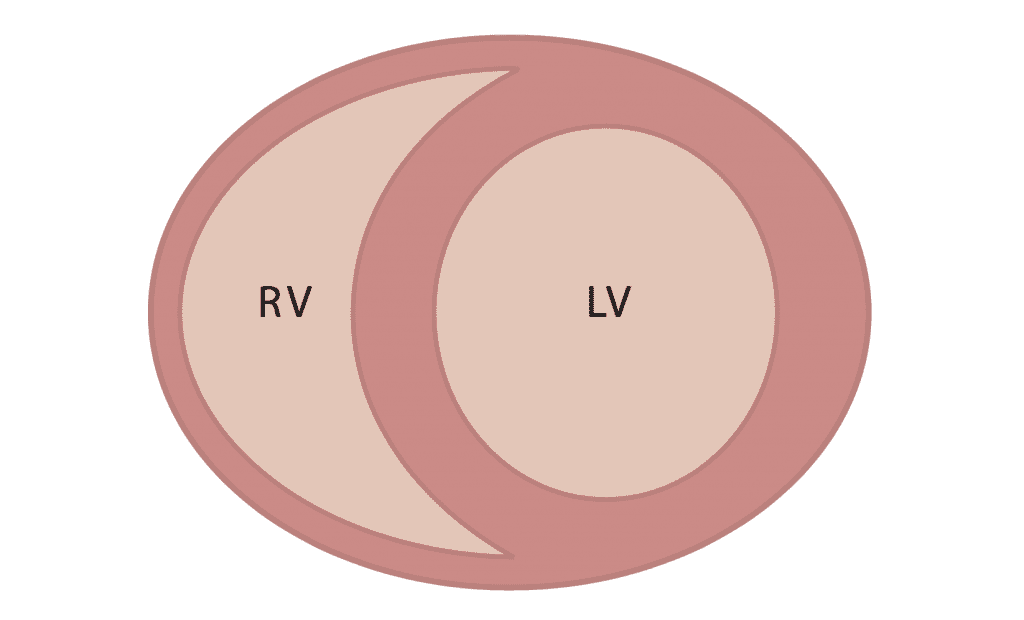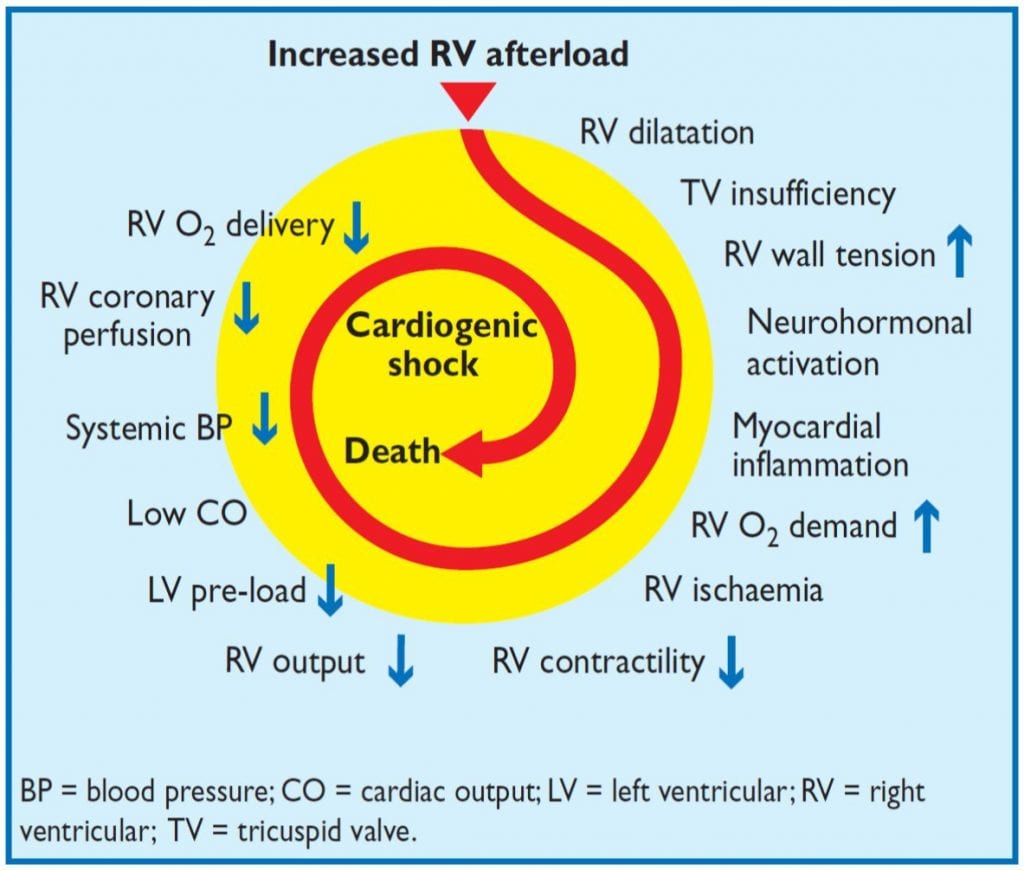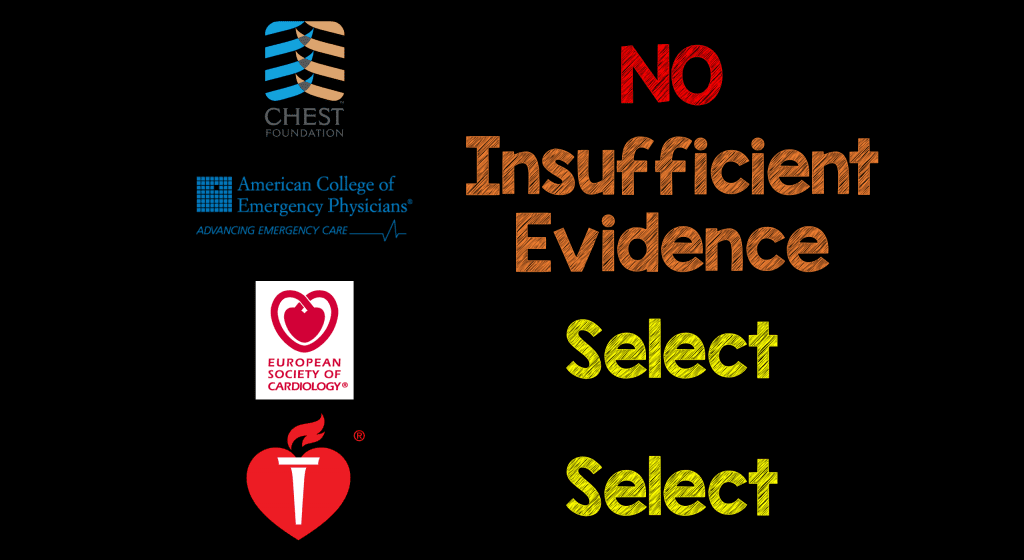
 Background: Previously, I had given a talk on the use of thrombolytics in submassive PE in 2016. This year, I had the privilege of speaking at ACOEP 2017 again with an update on the critical pulmonary embolism patient. This post will serve as a reference for that talk.
Background: Previously, I had given a talk on the use of thrombolytics in submassive PE in 2016. This year, I had the privilege of speaking at ACOEP 2017 again with an update on the critical pulmonary embolism patient. This post will serve as a reference for that talk.
There are many ways to classify pulmonary embolism, but the best clinical definition would depend on the hemodynamic consequences. For example, massive pulmonary embolism can be defined as systemic hypotension (SBP < 90 mmHg or a drop in SBP of at least 40mmHg for at least 15 min) or shock (tissue hypoperfusion, hypoxia, altered mental status, oliguria, or cool clammy extremities.) There is a second subset of patients that also warrant discussion; submassive pulmonary embolism. These patients are defined as lack of systemic hypotension (<90mmHg), but have right ventricular dysfunction/hypokinesis. RV dysfunction tells us that there is severe pulmonary artery obstruction and impending hemodynamic failure.
How is Submassive PE defined in the Literature:
- Acute PE without hypotension (SBP <90mmHg) but with any of the following:
- RV dysfunction on POCUS
- RV dilation (RV:LV Diameter >0.9 on POCUS)
- Elevated BNP (>500pg/mL)
- Elevated Troponin I (>0.4ng/mL)
- Elevated Troponin T (>0.1ng/mL)
- New ECG Changes (Complete or Incomplete RBBB, Anteroseptal ST-Segment Elevation/Depression, or Anterolateral T-Wave Inversion)
What are Some Ways to Define RV Dysfunction on Echocardiography?
- RV/LV End-Diastolic Diameter >1 in apical 4 chamber view
- RV End-Diastolic Diameter > 30mm
- Paradoxical Septal Systolic Motion
- McConnells Sign: Akinesia of RV free wall sparing the apex; Has been shown to have a specificity of 94% and sensitivity of 77% for diagnosing PE [4]
What About Surrogate Markers of RV Dysfunction?
No laboratory value alone can be used to make a diagnosis of massive or submassive PE, but when added together can help increase the pretest probability and determine prognosis
- EKG: No findings are highly sensitive or specific; sinus tachycardia, historically S1Q3T3 pattern, precordial T wave inversions (V1 – V4), New (complete or incomplete) right bundle branch block
- Elevated Troponin Levels: Associated with worse prognosis; OR 5.90 [7]
- Elevated BNP: Associated with worse prognosis; OR 9.51 [8]
Why is it Important to Identify Patients with Massive and Submassive PE?
Reviewing large registry trials, 30 day mortality for PE is about 3% [9 – 11]. Hypotension and RV dysfunction in the setting of acute pulmonary embolism are both associated with an increasing mortality [2].

The Right Ventricle is Not Like the Left Ventricle:
The RV has a crescent-shaped geometry, with fibers arranged in series (as opposed to parallel like the LV), and the RV free wall is thin with a low volume to surface ratio which makes it poorly tolerant to acute elevations in afterload. RV systolic function is also different in that systolic contraction occurs in 3 phases: papillary muscle contraction, inward movement of the RV free wall, and finally contraction of the LV causing medial displacement of the interventricular septum towards the RV. This final phase is important as too much fluid resuscitation can cause the interventricular septum to bow toward the LV.

Initial Resuscitation
Acute obstruction to RV outflow causes acute circulatory failure which is the leading cause of death in patients with submassive and massive PE. Therefore, initial stabilization should focus on hemodynamic support. We should also not forget about hypoxia and hypercarbia:
- Hypoxia and Hypercarbia: We want to avoid hypoxia and hypercarbia as these can result in pulmonary vasoconstriction. In patients with PE the clot in pulmonary arteries can create shunt physiology due to a lack of gas exchange. PEEP does a nice job of recruiting atelectatic alveoli and hence improving gas exchange (and thus hypoxia) in the lungs. We want to try and avoid intubation as this will decrease preload to the RV as we transition from negative pressure ventilation to positive pressure ventilation which increases intrathoracic pressures. Other options here include:
- HFNC
- BiPAP/CPAP
- BVM – Apneic CPAP Recruitment
-
Volume Expansion: Typically, in undifferentiated shock 1 – 2L of crystalloid are infused, however in the critical PE patient this may cause further increased RV pressure, which can lead to decreased RV coronary perfusion pressure, resulting in RV ischemia. In these patients we really want to limit the amount of fluids we are infusing.
- The Death Spiral: Increased RV Afterload (Acute PE) à IVF à Increased RV Wall Tension –> Increased RV O2 Demand –> Increased RV Ischemia –> Decreased RV Contractility –> Decreased LV Preload –> Decreased CO –> Decreased RV Coronary Perfusion Pressure –> Cardiogenic Shock à Death

- Vasopressors and Inotropes: Early use of vasopressors and inotropes can help enhance RV function. Norepinephrine would be an ideal agent as it helps increase MAP, improve RV function, without increasing pulmonary vascular pressures. Dobutamine and milrinone can help improve RV function and cardiac output while decreasing pulmonary vascular resistance. The main issue with these agents is they are vasodilatory and can worsen hypotension and should be used in conjunction with vasopressors.
- Pulmonary Vasodilators: Inhaled nitric oxide (NO) is very promising in the management of RV failure. Physiologically, it decreases pulmonary vascular resistance without reducing systemic pressures. It also appears to improve ventilation-perfusion mismatch
- Initial Resuscitation Summary: Escalating Therapy – Start with gentle hydration (500 mL), then consider the addition of a vasopressor early, followed by an inotrope. If the patient is still hemodynamically unstable, consider adding inhaled NO.

Medical Management:
This is the elephant in the room. When should we consider initiating thrombolytics, what dose, and how should we give anticoagulation?
- Thrombolysis: For simplicity sake, I will break this into Massive and Submassive Treatment

Massive PE: Thrombolytics are supported by several international organizations as first line therapy (ACCP, AHA, EHA, & ACEP)
- Wan et al 2004: Meta-analysis of 11 trials with 748 patients. RCTs of Thrombolysis + Anticoagulation vs Placebo + Anticoagulation. There was a reduction in recurrent PE or Death (9.4% vs 19.0%; NNT = 10) at the risk of increased major bleeding (21.9% vs 11.9%; NNH = 10)
- PEAPETT Trial 2016: Single center case series of 23 patients with PEA and cardiopulmonary arrest due to confirmed PE. All patients received 50mg of tPA as IV push over 1 minute. ROSC achieved in 22/23 patients and 20/23 (87%) still alive at 2 years of follow up. No major or minor bleeding.
- Wang C et al 2010: Prospective RCT of 118 patients with HD instability or massive pulmonary artery obstruction give 50mg/2h t-PA vs 100mg/2h tPA. There was no difference in pulmonary artery obstruction, recurrent PE, or Death, and with the half dose thrombolytics major bleeding was decreased (3% vs 10%).
Massive PE BOTTOM LINE: rt-PA 50mg over 2 hours has shown similar efficacy to 100mg over 2 hours in clinical outcomes with a better safety profile (less bleeding)
Submassive PE: Thrombolytic therapy controversial and confusing. The reason for the controversy is mortality benefits have been mixed amongst studies while there is a real 2 – 3% ICH rate with thrombolysis. Also, there have been no head-to-head comparisons of thrombolytic agents conducted, to help select one over another. International organizations can’t even agree on recommendations:

-
Full Dose Thrombolysis:
- MAPPET-3 2002: 256 patients randomized to alteplase + heparin vs placebo vs heparin. Primary endpoint was composite of in hospital death or clinical deterioration. There was no difference in mortality but decreased hemodynamic deterioration (NNT = 7) and interestingly no difference in major bleeding in this study
- TOPCOAT 2014: 83 patients with Submassive PE randomized to Tenecteplase + heparin vs placebo + heparin. Primary end point was composite of death and need for intubation or surgical thrombectomy at 5d – 6weeks. Again, no improvement in mortality with increased ICH (2.5% vs 0%; NNH = 40). There were some surrogate outcomes that were improved including: quality of life, RV function, and exercise capacity at 90d.
- PEITHO Trial (2014): Largest RCT to Date; Randomized 1006 patients with normal SBP and both RVD and elevated troponin to either heparin and tenecteplase or placebo and heparin. Primary outcome was composite end point of death from any cause or hemodynamic decompensation. The primary outcome occurred in 2.6% of patients in the tenecteplase arm and 5.6% of patients in the placebo group (NNT = 30). This result was predominately driven by hemodynamic decompensation and not mortality. The hemodynamic benefit occurred at the expense of increase major bleeding (11.5% vs 2.4%; NNH = 20) and ICH (2.4% vs 0.2%; NNH = 46)
- Chaterjee et al 2014 Meta-Analysis: 8 Trials with 1775 patients with submassive/intermediate risk PEs. All cause mortality was decresed with thrombolysis (1.39% vs 2.92%; NNT = 65), but again at the expense of major bleeding (7.74% vs 2.25%; NNH = 18) and ICH (1.46 vs 0.19%; NNH = 78)
- PEITHO Long-Term Follow Up 2017: Follow up to the original PEITHO trial with 709 patients followed up for a median of 37.8 months. No difference in mortality or morbidity (residual dyspnea, functional limitations, and persistent RV dysfunction).
- Full Dose Thrombolysis BOTTOM LINE: Data for mortality benefit is conflicted, but there is a significant decrease in hemodynamic decompensation, but at the cost of increased major bleeding and ICH
- Half Dose Thrombolysis:
- Levine et al 1990: 58 patients randomized to 0.6mg/kg (max of 50mg) of alteplase vs heparin alone. Primary outcome was clot burden on V/Q scan at 7d and 28d. Decreased clot burden with no major bleeding in either group. Mortality was not assessed
- MOPPET Trial 2013: 121 patients with submassive PE randomized to reduced dose rt-PA of 50mg for patients ≥50kg and 0.5mg/kg for those weighing <50kg. There was a reduction in the primary outcome of pulmonary htn defined by TTE at 28 months (16% vs 57%; NNT = 2) and a reduction in the combined end-point of death plus recurrent PE (1.6% vs 10%; NNT = 12). There was no major bleeding or ICH in either group.
- ½ Dose Thrombolysis BOTTOM LINE: Improves surrogate outcomes (i.e. mortality not the primary outcome in either study) and the added benefit of less major bleeding or ICH.
Full Dose vs Half Dose Thrombolysis:
- Zhang et al 2014 Meta-Analysis: 5 RCTs with 444 patients, but only 3 trials compared full dose with half dose thromboytics (100mg alteplase vs 0.6mg/kg, MAX Dose: 50mg). There was no difference in mortality or recurrent PE, but there was more major bleeding with full dose thrombolytics (4.3% vs 11.1%; NNH = 15)
- There have been 8 trials studying half dose alteplase in PE with 453 patients. In review of these studies there has been only 1 documented ICH (1/453 = 0.2%).

- Finally, I have never really understood why we give anticoagulation before, during, or immediately after thrombolysis. This seems like an equation for trouble (Anticoagulation + Thrombolysis = BAD). Instead I would hold anticoagulation before and during thrombolysis and not initiate until 2 – 3 hrs after thrombolysis and even consider giving a reduced dose.

-
No Thrombolysis (Anticoagulation Alone):
- Zhang et al 2014 Meta-Analysis: 5 RCTs with 444 patients, but two trials compared low dose 0.6mg/kg (MAX Dose 50mg/2hr) or 10mg Bolus + ≤40mg/2hr vs Heparin Drip Alone. There was no difference in major bleeding events, recurrent PE, or all cause mortality.
- Xu Q et al 2015 Meta-Analysis: Dreampanerai 7 trials with 1631 patients comparing full dose lytics vs half dose lytics, vs anticoagulation alone. Since the half dose lytic trials did not really evaluate hemodynamic decompensation, we have to use the full dose trials. In the full dose vs heparin trials, there was more hemodynamic decompensation in the anticoagulation alone arms (14.1% vs 8.4%; NNH = 18).
- No Thrombolysis BOTTOM LINE: In patients with submassive PE, anticoagulation alone, results in more hemodynamic decompensation.
-
Catheter Directed Thrombolytics (CDT):
- SEATTLE-2 Trial 2015: Single-arm prospective trial of treatment of acute PE (31 massive PE & 119 Submassive PE). Primary outcome was RV/LV ratio at 48hrs. Treatment decreased RV dilatation and pulmonary hypertension with zero cases of ICH. There was one major bleed, which was a groin hematoma that resulted in transient hypotension. The benefits in this study came at an increased cost and hospital length of stay (8.8d +/- 5)
- PERFECT Trial 2015: Prospective single arm study of 101 patients with acute PE (28 massive PE & 73 Submassive PE). In this trial there was less hemodynamic decompensation with no cases of ICH or major bleeding
- Catheter Directed Therapy Bottom Line: Evidence for catheter directed therapy is single arm studies without comparison to systemic thrombolysis or placebo. It is more expensive and causes longer length of ICU stay. This may be an option in patients with increased risk of ICH or major bleeding (i.e patients >65 years of age)
My Summary of Thrombolysis in Submassive PE:

Surgical Management (Not covered in my talk):
- Should be considered in patients with massive PE with contraindications to thrombolysis or no response to thrombolysis
- Surgical Embolectomy: Limited to large medical centers with experienced surgeons and cardiopulmonary bypass capabilities
Inferior Vena Cava Filter (Also not covered in my talk):
- Literature is mostly case series and case reports. These trials showed early reduction of recurrent PE but with late increase in recurrent DVT. The only real indication for filter placement is contraindication to anticoagulant treatment
- PREPIC Trial 1998: 400 patients with acute proximal DVT randomized to IV filter + anticoagulation vs coagulation alone. At 12 days filter placement resulted in 4% absolute reduction in PE incidence, but a doubling in recurrent DVT risk at 2 years (10% in no filter vs 20% with filter).
Clinical Take Home Points:
- Be careful with too much volume resuscitation as this can cause hemodynamic decompensation in patients with acute submassive/massive PEs
- Consider starting vasopressors/inotropes sooner than later
- In massive PE, half dose thrombolytics appears to be as effective as full dose thrombolytics with less bleeding
- Submassive PE is a spectrum of disease. Not all patients will require thrombolytics, but if they do, consider half dose thrombolytics
- Hold anticoagulation before and during thrombolysis, and do not initiate until 2 – 3 hrs after thrombolysis to decrease risk of major bleeding and ICH
- In patients who are at higher risk of bleeding or ICH (i.e. age ≥65), Catheter Directed Thrombolytics (CDT) may be an option (This will be institution dependent)
- In patients who have contraindications to thrombolytics or anticoagulation consider surgical embolectomy (This will be institution dependent)
- The only role for inferior vena cava filters is contraindications to anticoagulant treatment
References:
- Sekhri V et al. Management of Massive and Nonmassive Pulmonary Embolism. Arch Med Sci 2012. PMCID: PMC3542486
- Kasper et al. management Strategies and Determinates of Outcome in Acute Major Pulmonary Embolism: Results of a Multi-Center Registry JACC 1997. PMID: 9350909
- Matthews JC et al. Acute Right Ventricular Failure in the Setting of Acute Pulmonary Embolism or Chronic Pulmonary Hypertension: A Detailed Review of the Pathophysiology, Diagnosis, and Management. Curr Cardiol Rev 2008. PMCID: PMC2774585
- McConnell MV et al. Regional Right Ventricular Dysfunction Detected by Echocardiography in Acute Pulmonary Embolism Am J Cardiol 1996. PMID: 8752195
- Meyer G et al. Recent Advances in the management of Pulmonary Embolism: Focus on the Critically Ill Patients. Ann Intensive Care 2016. PMID: 26934891
- Jaff MR et al. Management of Massive and Submassive Pulmonary Embolism, Iliofemoral Deep Vein Thrombosis, and Chronic Thromboembolic Pulmonary Hypertension: A Scientific Statement form the American Heart Association. Circulation 2011. PMID: 21422387
- Becattini C et al. Prognostic Value of Troponins in Acute Pulmonary Embolism: A Meta-Analysis. Circulation 2007. PMID: 17606843
- Sanchez O et al. Prognostic Value of Right Ventricular Dysfunction in Patients with Hemodynamically Stable Pulmonary Embolism: A systematic Review. Eur Heart J 2008. PMID: 18495689
- Pollack CV et al. clinical Characteristics, Management, and Outcomes of Patients Diagnosed with Acute Pulmonary Embolism in the Emergency Department: Initial Report of EMPEROR (Multicenter Emergency Medicine Pulmonary Embolism in the Real World Registry). JACC 2011. PMID: 21292129
- Lobo JL et al. Clinical Syndromes and Clinical Outcome in Patients with Pulmonary Embolism: Findrings from the RIETE Registry. CHEST 2006. PMID: 17167002
- Schissler AJ et al. National Trends in Emergency Room Diagnosis of Pulmonary Embolism, 2011 – 2010: A Cross-Sectional Study. Respir Res 2015. PMCID: PMC4391335
For More Thoughts on This Topic Checkout:
- Josh Farkas at PulmCrit (EMCrit): Submassive PE 2017 – Getting ‘em Off the Cliff
- Josh Farkas at PulmCrit (EMCrit): Eight Pearls for the Crashing Patient with Massive PE
- Salim Rezaie at REBEL EM: Treatment of Submassive Pulmonary Embolism (PE): Full Dose, Half Dose, or No Dose?
- Anand Swaminathan at St. Emlyn’s Blog: The Argument for Systemic Thrombolytics in Submassive Pulmonary Embolism
Post Peer Reviewed By: Anand Swaminathan (Twitter: @EMSwami)
The post The Critical Pulmonary Embolism Patient appeared first on REBEL EM - Emergency Medicine Blog.
